Chen Yongping, Southeast University, AFM: enhanced thermoelectric, stretchable and cryopreserved organic hydrogel thermal batteries continue to operate at zero temperatures.
abstract
Water based thermal batteries, which are environmentally friendly and can continuously convert low-level heat into electricity, are promising candidates to power flexible and wearable devices in various application scenarios. However, the challenges still lie in its limited operating temperature, mechanical brittleness and poor thermoelectric performance, mainly due to the entropy reduction of polymer chains and thermocouples at low temperatures.
Recently, Professor Chen Yongping s team of Southeast University has solved these challenges by introducing synergistic liquid separation effect to destroy strong hydrogen bonds, increase the entropy elasticity of polymers and expand the entropy difference of thermocouple ions. The organic hydrogel thermal battery is designed with out of liquid comonomer and out of liquid cosolvent. The maximum normalized power density of the thermal battery is 0.1 mwm-2k-2, which is in the same order of magnitude as the current record of quasi solid thermal battery. Even at - 30 ° The elongation at break and the relative high power density of 0.012 mwm-2k-2 were still maintained at 100% C. In addition, the thermal battery shows the potential to light up the LED, and can work stably in a wide temperature range of compression, bending and stretching. This work provides insights into the development of reliable power sources to continuously drive flexible electronic devices in extremely cold environments. The related papers, entitled stretchable and freeze tolerant organohydrogen thermocells with enhanced thermoelectric performance continuously working at sub zero temperatures, were published in advanced functional materials.
Main picture
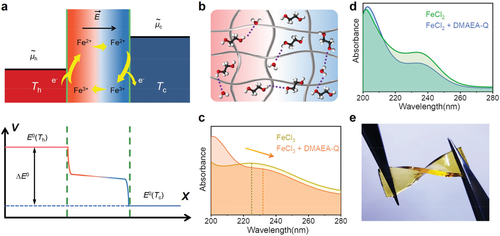
Figure 1 design of a thermal battery operating at sub zero temperature. The design of thermal battery working under the temperature below zero. a) The electrochemical potential (𝜇 ~) carrying diagram of charge and the corresponding voltage distribution of reversible redox reaction Fe3 + + e − ⇋ Fe2 +, where e is the built-in electric field. B) a schematic diagram of an organic hydrogel thermal battery containing a crosslinking network, EG and water under temperature gradient. The extra eg can destroy the ice lattice and expand the operating temperature below zero. c) The UV Vis spectra of FeCl3 and the mixture of dmaea-q and FeCl3 in the binary solvent system of EG and water were studied. d) The UV Vis spectra of FeCl2 and the mixture of dmaea-q and FeCl2 in the binary solvent system of EG and water were studied. E) photographs of soft and stretchable organic hydrogel thermal batteries.
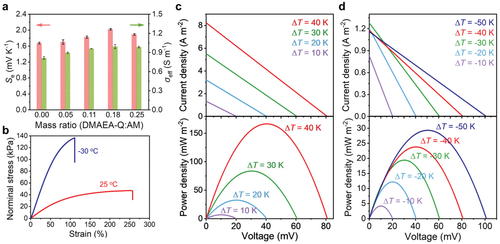
Fig. 2 thermoelectric and mechanical properties of organic hydrogel thermal batteries.
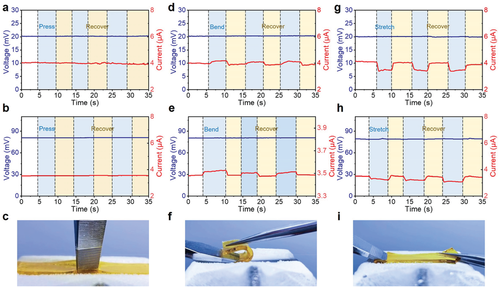
Fig. 3 the output voltage and current of the organic hydrogel thermal cell during the deformation process.
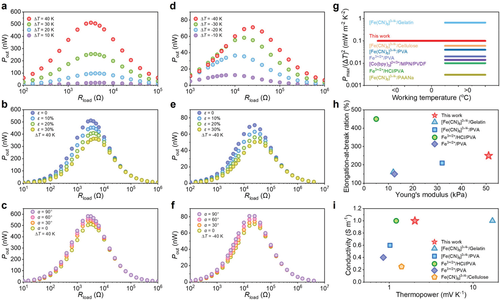
Fig. 4 the output power of the organic hydrogel thermal cell during the deformation process and the comparison with the existing quasi solid thermal battery.
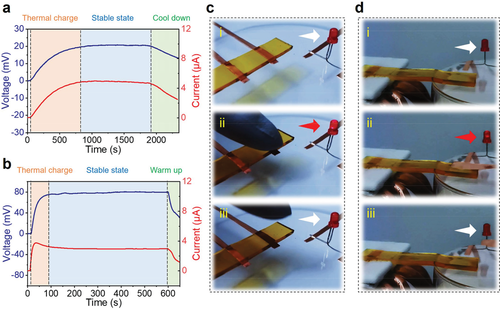
Figure 5 demonstration of the concept of lighting up LED in room temperature or cold environment using an organic hydrogel thermal battery. a) By collecting human body heat in the surrounding environment to continuously output voltage (blue line) and current (red line). b) Continuous output voltage (blue line) and current (red line) by collecting temperature gradient between ice surface and room temperature. C) organic hydrogel thermal batteries illuminate red LED photos by collecting body heat in the surrounding environment. D) by collecting the temperature gradient between the ice and room temperature, the organic hydrogel thermal battery illuminated the red LED photos.
summary
The team designed an organic hydrogel thermal battery with a synergistic liquid release effect, which is essentially stretchable and environmentally friendly, to solve the challenges faced by the power supply at very low temperatures, such as wear resistance, flexibility and continuous working mode. The organic hydrogel thermal battery is not only in -50, but also affects the strong hydrogen bond through the ionization effect. ° It can also resist freezing and show enhanced thermoelectric potential at C. The maximum normalized power density of the thermal battery is 0.1 mwm-2k-2, which is in the same order of magnitude as the current record of quasi solid thermal battery. Even at - 30 ° Under C, the organic hydrogel thermal battery still maintains over 100% elongation at break and 0.012 mW m-2 K-2 relative high power density. In addition, the team proved that the organic hydrogel thermal battery can brighten the LED and provide stable voltage output during compression, bending and stretching in a wide temperature range. It is reported that it is the first generation of flexible extensible thermal battery that can work in extremely cold environment. The team believes that the working mechanism and lift off effects studied in this work will also provide inspiration for solving the challenges faced by scalable, wearable and portable devices that need continuous power supply at high altitude, Antarctic / Arctic and even outer space
This information is from the Internet for academic exchange only. If there is any infringement, please contact us to delete it immediately
+86-18915413828(WhatsApp&WeChat)
Previous: The function of ACS Na


